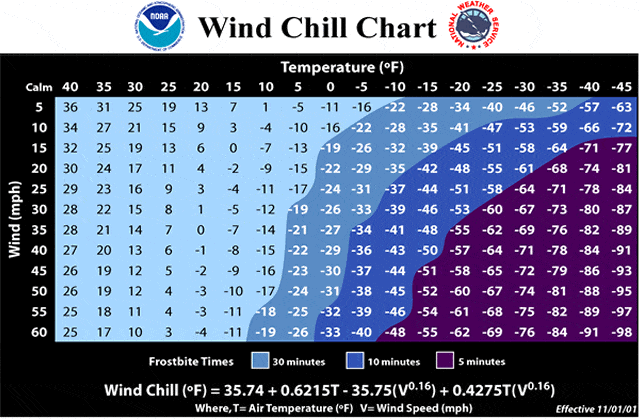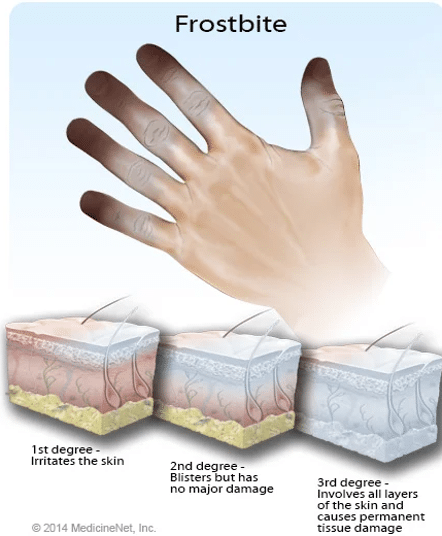With Fall coming to a close and Winter fast approaching, it is time to prepare for the harsh weather conditions that the season brings. In past years, Winter temperatures in Alberta have reached well into the -30°C’s and lower than -40°C at times – and that’s before taking the wind speeds into account.
People exposed to extreme cold are susceptible to frostbite in a matter of minutes, depending on the temperature and wind chill. See the Wind Chill Chart below to understand how temperature and wind speed play a huge role in how quickly frostbite can occur.

The body parts most at-risk for getting frostbite are our outer extremities such as; hands, feet, ears, nose, lips, and cheeks.
It is very important and potentially extremity saving to be able to identify the signs of frostbite. When our bodies become cold, blood flow to our extremities slows down so that blood flow to our vital organs can increase. Therefore, our extremities become colder and fluid in our tissue can begin to freeze.
There are 3 Stages of Frostbite:

What Should You do if You Have Frostbite?
If you suspect that you have frostbite, it is important to head indoors immediately. Removing yourself from the cold air/winds will stop the frostbite from getting worse. However, if you cannot get indoors immediately, cover the affected area to protect it from the cold. Frostbitten hands should be tucked into armpits and other extremities should be covered/wrapped with a dry piece of fabric.
Once indoors, try to gradually rewarm and bring back feeling to the affected body part(s). Remove wet clothes and wrap up in a warm blanket immediately. Soak frostbitten fingers, toes or other extremities in warm water (NEVER HOT). For your nose, ears, and cheeks, place and hold a wet warm cloth against the affected area.

Never rewarm frostbitten skin with direct heat, such as stovetop, heat lamp, fireplace, heating pad, placing hands on a hot cup or by rubbing. This can cause burns and further damage to the skin.
Keeping yourself hydrated with warm fluids will also help rewarm your body from the inside. See a medical professional immediately if feeling does not return to the affected area, or if skin begins to turn grey.
So, What Can we do to Prevent Frostbite?
Layers, layers, layers! By protecting yourself with multiple layers, warm air will become trapped between the layers. This will result in your body staying warm for longer! Ensure all body parts, especially extremities, are protected and covered at all times. The key is to stay dry! Layering clothing made of cotton or wool will help greatly.
Carrying hand and feet warmers will prove to be extremely beneficial as well – some brands can stay warm for up to 10 hours or more. Remember, depending on the wind chill, frostbite can occur in mere minutes! It is important to take frequent warm-up breaks in a sheltered and heated area. During warm-up breaks, be sure to drink fluids and stay hydrated – dehydration can greatly increase the likelihood of getting frostbite.
Look out for one another! We have a huge disadvantage when it comes to picking up on early signs of frostbite on our face and ears. We can’t see our own faces, so we have to rely on others around us to let us know if something looks wrong. Don’t only pay attention to yourself – be sure to be looking out for other people around you as well!
Would you like to know more or have questions? Please reach out to a JADA Solutions team member below and we will be glad to assist. You can also drop a comment below and we will be sure to get back to you!
Leave us a Comment
Contact our Team!
How Can We Help You?
Contact us at JADA Solutions (HSE) Inc. to speak with one of our professionals!
Newsletter
What is Sick Building Syndrome? 🏢
Learn about some common causes, risk factors and prevention methods in our latest blog post:
#sickbuildingsyndrome #indoorairquality #iaq #hseblog
Did you know that March is Workplace Eye Safety and Wellness Month? 👀
Our latest blog post covers common risks & tips for optimal Eye Health and Safety. ✍
Learn more:
-
#eyehealth #eyesafety #eyewellness #healthandsafety #hse
